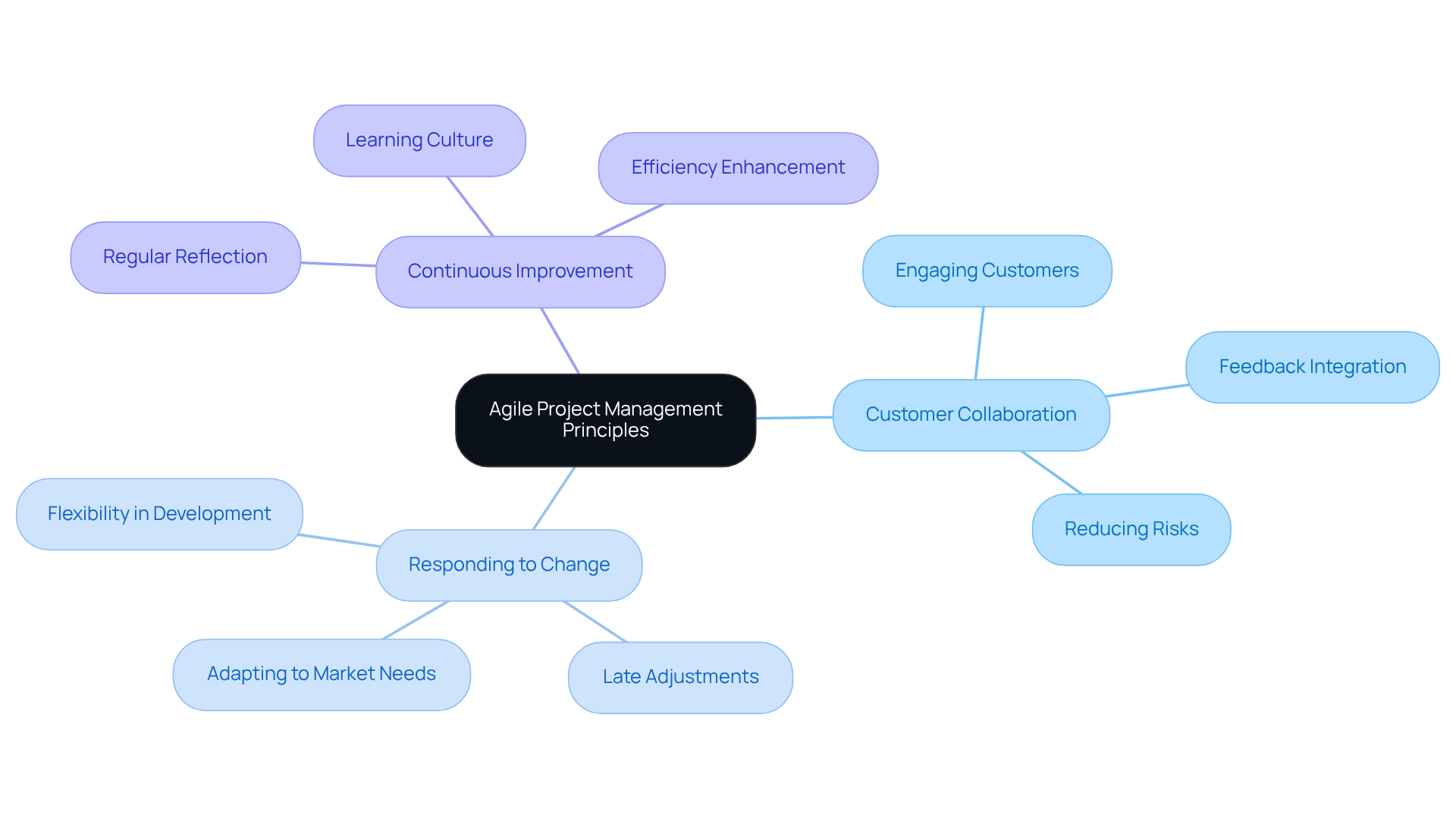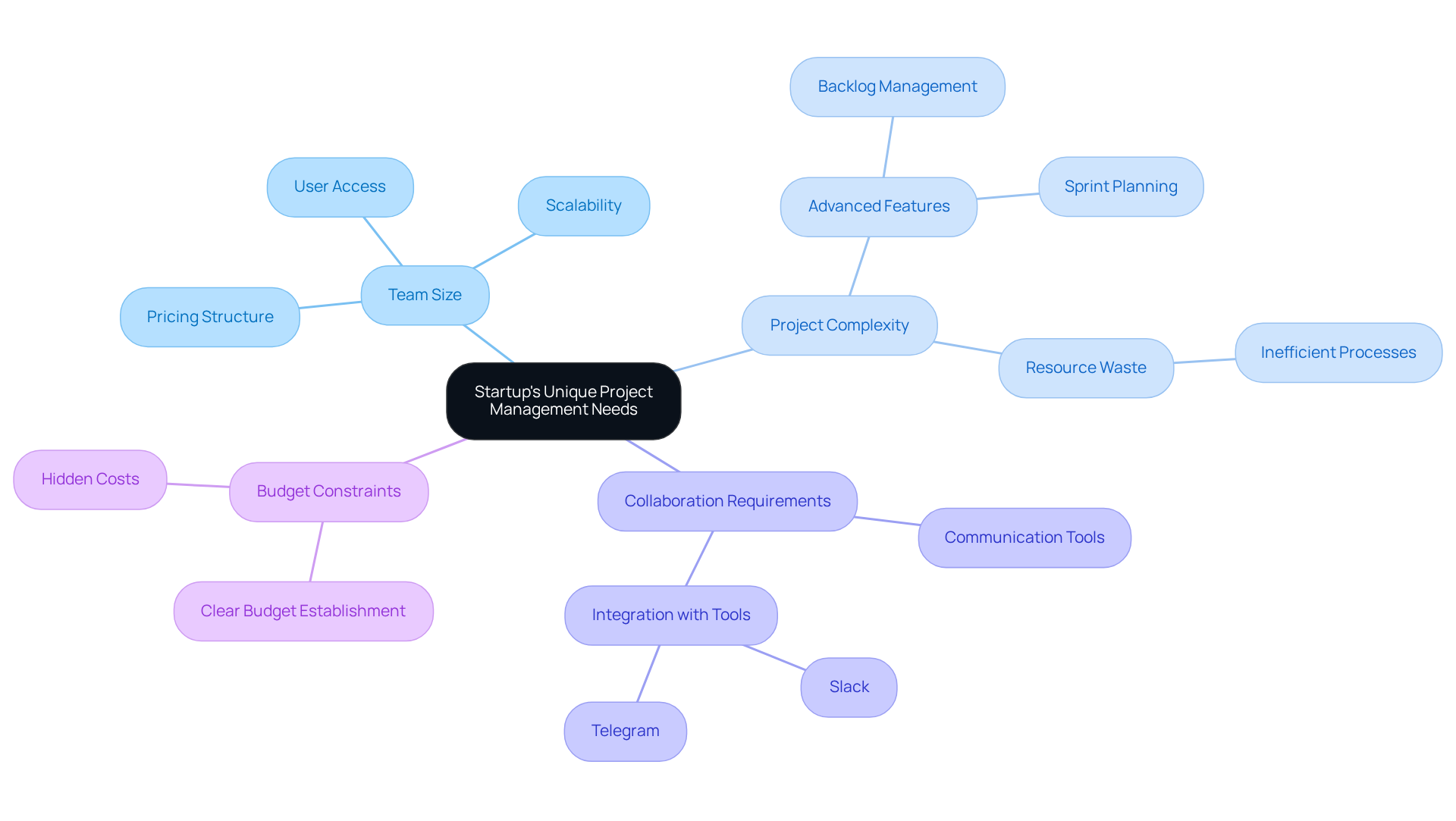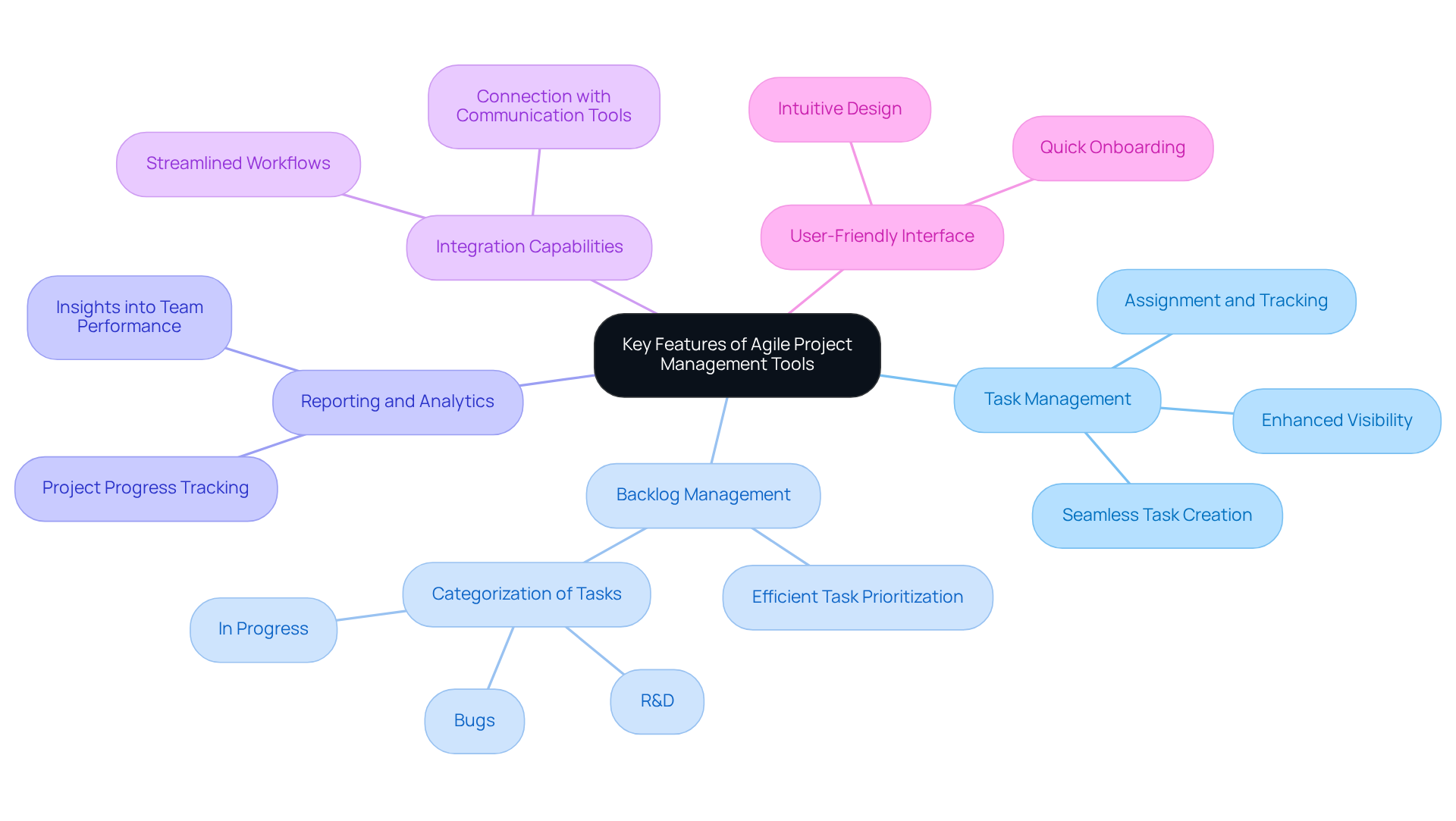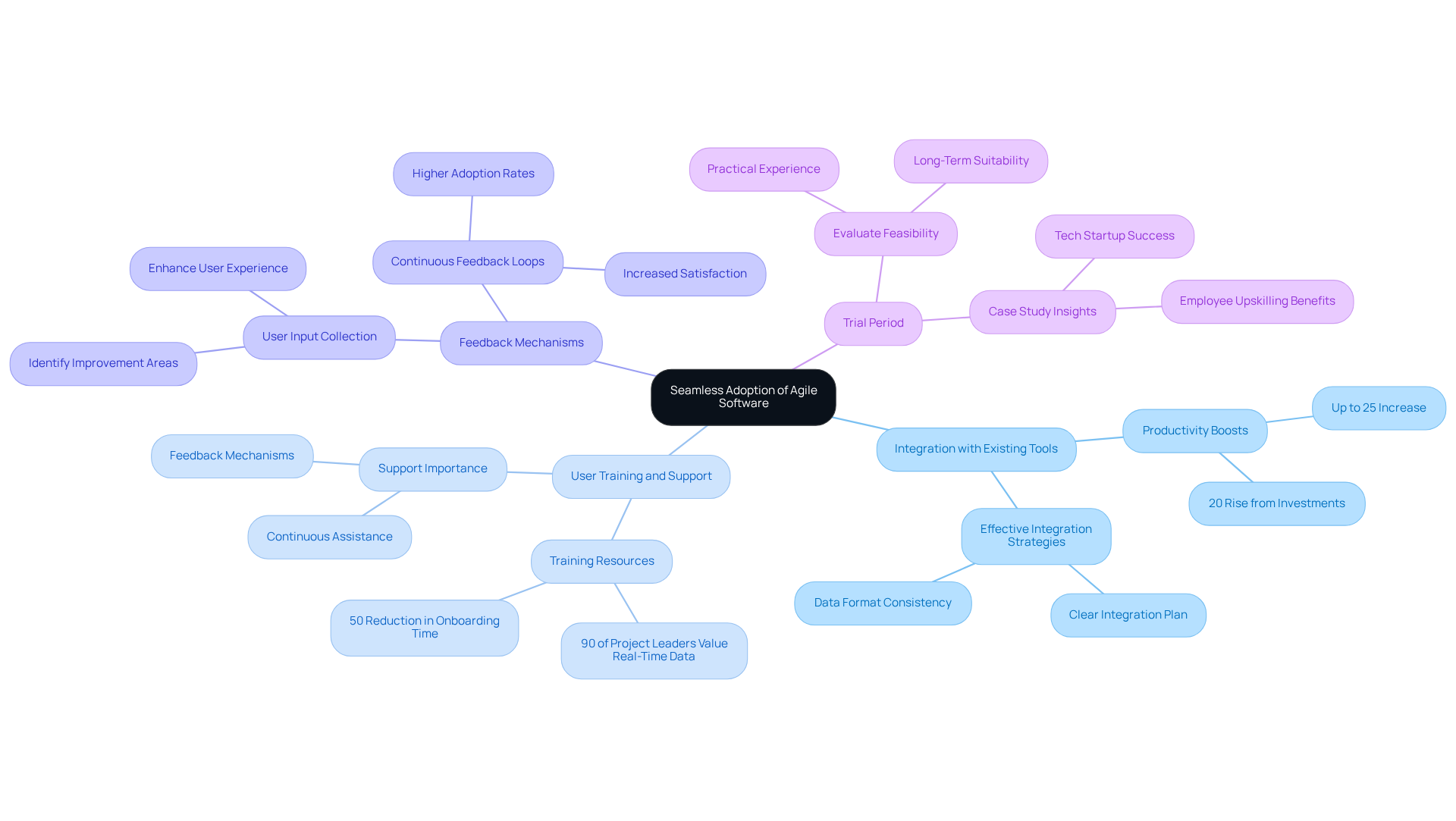Overview
This article delineates four essential steps for selecting the right Agile project management software. It emphasizes the critical nature of:
- Understanding unique project needs
- Evaluating key features
- Considering integration and user experience
- Ensuring effective training and support
By meticulously analyzing factors such as team size, project complexity, and integration capabilities, startups can make informed decisions. These decisions not only enhance productivity but also streamline project management processes, ultimately driving success.
Introduction
Selecting the right agile project management software is a pivotal decision for startups navigating the complexities of modern business. As agile methodologies gain traction across various sectors, it becomes essential to choose a tool that aligns with a team’s unique needs. What criteria should startups consider to ensure their chosen software not only meets current demands but also adapts to future challenges? Understanding these factors is critical for long-term success.
Understand Agile Project Management Principles
Flexible management emphasizes iterative development, breaking endeavors into smaller, manageable components known as sprints. The key principles are as follows:
- Customer Collaboration: Engaging actively with customers throughout the project lifecycle is essential. This ongoing dialogue ensures that their needs and feedback are continuously integrated, leading to a product that genuinely meets market demands.
- Responding to Change: Flexibility is a cornerstone of adaptive methodologies. Teams must be ready to adapt to changes, even late in the development process, allowing for adjustments that enhance the final outcome.
- Continuous Improvement: Regular reflection on processes and outcomes fosters a culture of learning. By assessing what works and what doesn’t, teams can enhance their efficiency and effectiveness over time.
Agile project management software is expanding beyond IT into areas such as marketing, HR, sales, and finance, making it relevant for various functions within startups. The incorporation of AI and machine learning into flexible methodologies is also a significant trend, providing opportunities for enhanced planning and resource optimization. Furthermore, the rising demand for flexible approaches, as highlighted by the State of Agile Marketing Report 2024, indicates that 86% of marketers intend to shift some or all their teams to flexible methodologies. This focus on customer cooperation not only reduces risks but also fosters innovation, making it a crucial priority for flexible management in 2025.

Identify Your Startup's Unique Project Management Needs
Selecting the appropriate agile project management software begins with a thorough evaluation of your startup's unique requirements. Consider these key factors:
- Team Size: Identify the number of users who will require access to the software. This assessment will guide you in determining the scalability of the solution and its pricing structure. Remember, the best application must align with your budget while covering all the essentials for your startup’s daily operations.
- Project Complexity: Analyze the complexity of your projects. If your work involves intricate tasks, advanced features such as backlog management or sprint planning may be necessary to streamline processes effectively. Ineffective procedures can lead to as much as 12% waste of resources, underscoring the importance of meticulously assessing your application choices.
- Collaboration Requirements: Understand how your team collaborates. If your workflow relies on communication tools like Slack or Telegram, ensure the application can integrate seamlessly with these platforms to enhance productivity. For example, Casy's integration with chat platforms facilitates automated task creation, significantly reducing administrative overhead.
- Budget Constraints: Establish a clear budget for application expenses, considering potential hidden costs associated with additional features or user licenses.
By establishing these fundamental standards, you can more efficiently evaluate alternatives that will deliver maximum value to your team, ensuring a smoother management experience. As Beatrice Manuel noted, "The best software for you must fit within your budget and cover all the essentials for your startup’s day-to-day needs.

Evaluate Key Features of Agile Project Management Tools
When evaluating agile project management software, it is essential to focus on several key features that significantly impact task management effectiveness.
For task management, prioritize agile project management software that facilitates seamless task creation, assignment, and tracking. Effective task management is crucial; studies show that Agile initiatives are 28% more successful than conventional ones, largely due to enhanced visibility and cooperation.
Backlog management is essential; therefore, the agile project management software must efficiently manage a backlog of tasks, enabling teams to prioritize effectively. Casy excels in this area by categorizing tasks into R&D, Bugs, and In Progress, offering clear visibility for colleagues and enhancing overall management efficiency.
- Reporting and Analytics: Select agile project management software that offers strong reporting features to provide insights into team performance and project progress. This feature is vital for ongoing enhancement and assists teams in adjusting swiftly to shifting priorities.
Ensure that the agile project management software has integration capabilities to connect with other vital tools utilized, such as communication platforms and file storage services. Integration enhances collaboration and streamlines workflows, reducing administrative overhead.
A user-friendly interface in agile project management software is essential for ensuring team adoption and minimizing training time. Tools like Casy, with their intuitive designs, facilitate quick onboarding and enhance user experience.
By focusing on these attributes, especially Casy's distinctive abilities, you can choose a tool that not only aligns with your flexible approach but also greatly enhances your team's productivity.

Consider Integration and User Experience for Seamless Adoption
To ensure a seamless adoption of your chosen Agile project management software, consider the following key aspects:
- Integration with Existing Tools: Select software that integrates effortlessly with tools your team already utilizes, such as email, calendars, and chat applications. Effective integration minimizes disruptions and enhances workflow continuity. Organizations that successfully integrate multiple tools can experience productivity boosts of up to 25%. Moreover, organizations investing in management tools experience a 20% rise in productivity, further highlighting the significance of seamless integration.
- User Training and Support: Choose a platform that offers extensive training resources and strong customer support. Studies show that 90% of project leaders believe access to real-time information improves decision-making skills. This underscores the necessity for efficient training to optimize tool usage. Additionally, 90% of team members reported enhanced task tracking and accountability following the implementation of the system, emphasizing the considerable effect of user training. A well-structured training plan can significantly reduce onboarding time, as evidenced by a tech startup that achieved a 50% reduction in this area by prioritizing employee upskilling during tool integration.
- Feedback Mechanisms: Implement a system for collecting user input on the application. This allows for the identification of areas needing improvement and ensures that any issues are addressed promptly. Continuous feedback loops can enhance user experience, leading to higher adoption rates and satisfaction. Continuous assistance and upkeep are also essential for resolving problems and ensuring effective utilization of the application.
- Trial Period: Utilize free trials to enable your group to evaluate the program before making a commitment. This practical experience is essential for assessing the application's feasibility and long-term suitability, ensuring it fulfills your group's particular requirements. The case study of a tech startup illustrates the benefits of prioritizing employee upskilling during tool integration, which can lead to significant reductions in onboarding time.
By prioritizing integration and user experience, you can facilitate a smoother transition to agile project management software, ultimately enhancing overall team productivity.

Conclusion
Choosing the right agile project management software is not just a decision; it is a pivotal factor that can greatly influence a startup's success. By grasping the core principles of agile methodologies—such as customer collaboration, adaptability to change, and continuous improvement—teams can select tools that not only align with their operational needs but also enhance overall productivity.
Key factors for selecting the appropriate software include:
- Assessing team size
- Project complexity
- Collaboration requirements
- Budget constraints
Additionally, evaluating essential features like:
- Task management
- Backlog organization
- Reporting capabilities
- Integration with existing tools
is crucial. Ensuring a user-friendly experience and providing adequate training and support are vital for fostering a smooth transition and maximizing the software's effectiveness.
In conclusion, the importance of adopting agile project management software cannot be overstated, particularly in a fast-paced startup environment. By thoroughly evaluating unique project management needs and prioritizing integration and user experience, startups can streamline their processes and empower their teams to thrive. Embracing these agile principles and selecting the right tools will ultimately lead to improved collaboration, enhanced innovation, and a greater ability to respond to changing market demands.
Frequently Asked Questions
What are the key principles of Agile project management?
The key principles of Agile project management include Customer Collaboration, Responding to Change, and Continuous Improvement. These principles emphasize ongoing engagement with customers, adaptability to changes, and regular reflection on processes to enhance efficiency.
How does customer collaboration benefit Agile project management?
Customer collaboration ensures that customer needs and feedback are continuously integrated throughout the project lifecycle, leading to a product that better meets market demands.
Why is flexibility important in Agile project management?
Flexibility allows teams to adapt to changes even late in the development process, enabling adjustments that can enhance the final outcome of the project.
What role does continuous improvement play in Agile methodologies?
Continuous improvement fosters a culture of learning by encouraging teams to regularly assess what works and what doesn’t, thereby enhancing their efficiency and effectiveness over time.
In which areas is Agile project management software being utilized beyond IT?
Agile project management software is expanding into areas such as marketing, HR, sales, and finance, making it relevant for various functions within startups.
What trends are emerging in Agile project management?
A significant trend is the incorporation of AI and machine learning into flexible methodologies, providing opportunities for enhanced planning and resource optimization.
What does the State of Agile Marketing Report 2024 indicate about the future of Agile methodologies?
The report indicates that 86% of marketers intend to shift some or all their teams to flexible methodologies, highlighting the rising demand for such approaches.
How does a focus on customer cooperation impact Agile project management?
A focus on customer cooperation reduces risks and fosters innovation, making it a crucial priority for flexible management in 2025.




